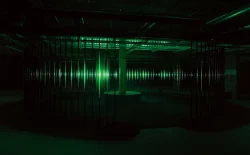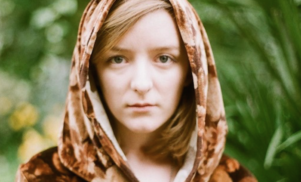The time between finishing an album and getting it out to the world can be spent many ways.
Whether resting for an eventual tour or moving through the few months that make up a press cycle there’s a lot of waiting to be done. That wait can either be a relaxed recovery period or an extremely busy time. Anna Mayberry has been experiencing that limbo lately as she gets ready to release Sallows, her debut album as ANAMAI, and even though it’s something she’s worked on for years she gives no impression of needing to a rest.
As winter blows through the city of Toronto, Mayberry has been out writing new songs, taking dance classes, filming music videos, piloting a small ferry in the harbor, and touring with her other band HSY. She also found the time to learn how to drive a car and start a new dance collective. Considering the smoldering intensity of Sallows she’ll only get busier once it begins winning fans, but the peaceful air of her music gives the impression that she can handle it.
Unlike the searing noise rock of her band HSY, ANAMAI is intimate in every possible way. Drawing inspiration from her upbringing in a Toronto folk community Mayberry brings a naturalistic beauty to her project even while blending it with electronic soundscapes built with David Psutka, the producer best known as Egyptrixx. The natural and electronic world never feel at odds on Sallows, rather they ebb and flow with a dreamy ease allowing a perfect foundation for Mayberry’s whispered, yearning lyrics. Echoed in song titles like ‘Mute Flames’ and ‘Altar Coals’, ANAMAI have crafted an album that is somnambulantly graceful, yet impossible to ever burn out into background music.
Sallows is out March 10 via Buzz Records. Stream it for the first time below and read our interview where I caught up with ANAMAI over email to talk about the origins of the project, Mayberry’s unique upbringing, and what lies ahead for one of 2015’s most exciting new acts.
What have you been up to since finishing Sallows?
Anna: It’s been winter for an eternity here, but I’m not very good at sitting still. Since we recorded the record last summer I’ve been piloting a small ferry in Toronto Harbour, touring with HSY, making music videos, writing new songs, taking contemporary dance workshops, starting a dance collective called Open Fortress, and learning to drive a car.
When did you first begin to develop ANAMAI? When did you start working with David?
David: I met Anna through a mutual friend in Montreal, while on tour with Modeselektor. Maybe she doesn’t remember this, but our first ever interaction was Anna ‘face dancing’ for me outside our tour bus, after which we all got pretty drunk. Initially Anna was sending me some demos of solo material and recording them casually at my studio – over 16 months or so the project drifted into a pretty honest collaboration and probably crystallized while recording the LP and playing early shows.
Anna: It was the beginning of an upswing for me. I had written a bunch of songs from a pretty dark place when I was living alone in Montreal and studying dance. I had a lot of doubts about how I was spending my time, the value of dance, of art education, of my own artistic practice. David was one of the first people I showed these songs to, probably because he was basically a stranger. I kind of thought he was full of it when he said he wanted to hear them- but it set a really honest and generous relationship between us. I moved to Toronto soon after, joined HSY, and ANAMAI started to make more and more sense.
What was the process like between writing the lyrics and recording the music? There’s this really organic interplay between the two, this sense that they’re reacting and responding to one another in real time from the moment ‘Lucia’ starts.
Anna: I mostly write lyrics while I’m doing other things, walking around the city or riding my bike especially. I often sing in public. The songs are never done until I’ve played them in front of people though – then I know what feels essential and I can let the rest go. I trust live performance more than recordings, because it’s an exchange of energy. Recording sometimes feels to me like looking in the mirror too long or something. The only song that wasn’t ‘finished’ when we recorded it is ‘Otolith’, and it’s actually my favourite song on the record. Next time we record I think the writing and recording will be more intertwined.
Both your EP and Sallows feel so unique on the Buzz Records roster which I usually associat with acts like Greys, Odonis Odonis, and your other band HSY. Everyone seems really supportive of each other there. What was it like when you first start sharing this project with that crew? Were they excited?
Anna: That gang is crazy supportive! Everyone I’ve met through HSY and Buzz devotes a lot of time and love to each other’s work. I really had nothing to lose by showing them my recordings. It’s like – we made this music, we are going to make some tapes to sell at our shows. Do you want to help? The fact that they have continued to invest in the project with us is a blessing.
Going a bit further, Toronto as a whole seems like such a supportive city. I interviewed Stefan Babcock from PUP a couple years ago and it always stuck out to me the way he talked about the music scene like a family. How did you first become a part of it and what has your experience been like?
Anna: I grew up in Toronto, and I started going to local shows when I was about 14. I looked like I was 12 so it wasn’t always easy. I had a karaoke style band with my best friends and we played bars by sneaking in before the bouncers at 6pm, or at DIY spots that were basically teenaged dreamspaces. There definitely isn’t one music ‘scene’ in Toronto – for example I have never met or seen PUP – but there are tons of musicians that hold each other up as much as they physically can. I remember feeling at one point when I first started playing in HSY and ANAMAI that the bulk of the money going around between the people I knew could have been counterfeit and no one would care – it was all just being passed from one band’s merch box to another anyway. No one was going to the bank. The feeling of giving everything you have to your favourite artists is enormous.
I love the entire structure of the album. I listened to Sallows first, but when I went back to hear the EP I was really surprised that it was actually used in the middle section of the album so seamlessly. There’s this ebb and flow that makes it so satisfying to hear in one sitting. Was it tough finding a way to fit the songs together or fitting the EP’s songs into this bigger context?
David: We debated including the 3 EP songs on the album, but I’m glad we did. They are – in many ways – a part of this body of material and belong there. The record turned out quite cohesive.
Anna: I think we laid the album out in about three minutes. We knew how it should feel. Once we had played everything live, it just fell into place.
I read that when you were growing up you were exposed to a lot of traditional English and American music. In what way? Was that something you’ve always been interested in, or did it kind of come back to you with this project?
Anna: I was born into a sprawling folk community, where I thought that I had about twenty cousins until I found out what ‘cousin’ actually means. Every year on May 1st, they all get up at dawn and Morris Dance in High Park and then return to my parent’s house for drinking and dancing and playing music. Fiddle, banjo, piano, melodeon, step dancing – that kind of thing. There are all these traditional songs that I have known by ear since I was little, sleeping under a table at parties. It’s a very low-risk environment for learning to sing in harmony, which is the biggest gift that this community gave me. ANAMAI lets me explore my love of singing in a much broader context.
Some of these songs, especially ‘Lucia’, ‘Everyone’, and ‘Half’ feel so dreamlike lyrically, but they’re anything but passive. The vocals are so arresting and powerful. How did the lyrics for this album come together?
Anna: I almost always write confessionally, trying to pinpoint the words that are exactly true. I am constantly wrestling with idealism, fantasy and memory in opposition to truth. I don’t believe in escape from confrontation, but I do trust intuition and dreams to guide my body in the physical world.
Sallows doesn’t sound like much else to me, one of the only things it reminds me of is Grouper’s Dragging A Dead Deer Up A Hill. What’s some of the music that influenced this record.
Anna: I remember when I first heard that Grouper record. It pierced me. I can only hope to make something as affecting as her music. My process has been influenced by Sam Amidon, as another folk-child who found new ways to channel those rich traditions, and eternally by Joanna Newsom, who has had a hold on my heart for a very long time. Playing loud music in HSY has also changed how I conceive of sound arrangement, despite the opposing properties of the two projects.
What are your plans for performing live this year? It must be really different compared to playing live in HSY. How do you approach it.
Anna: We have some shows coming up over the next few months, including one that will be a structured improv including dance which we are really excited about. The live ANAMAI sets are getting louder as we play in larger venues – but there is an intimacy that we try to retain wherever we get to perform. The energy we put out is much calmer than HSY. I love it when people sit or lie down at our shows. I hope this keeps happening.






























